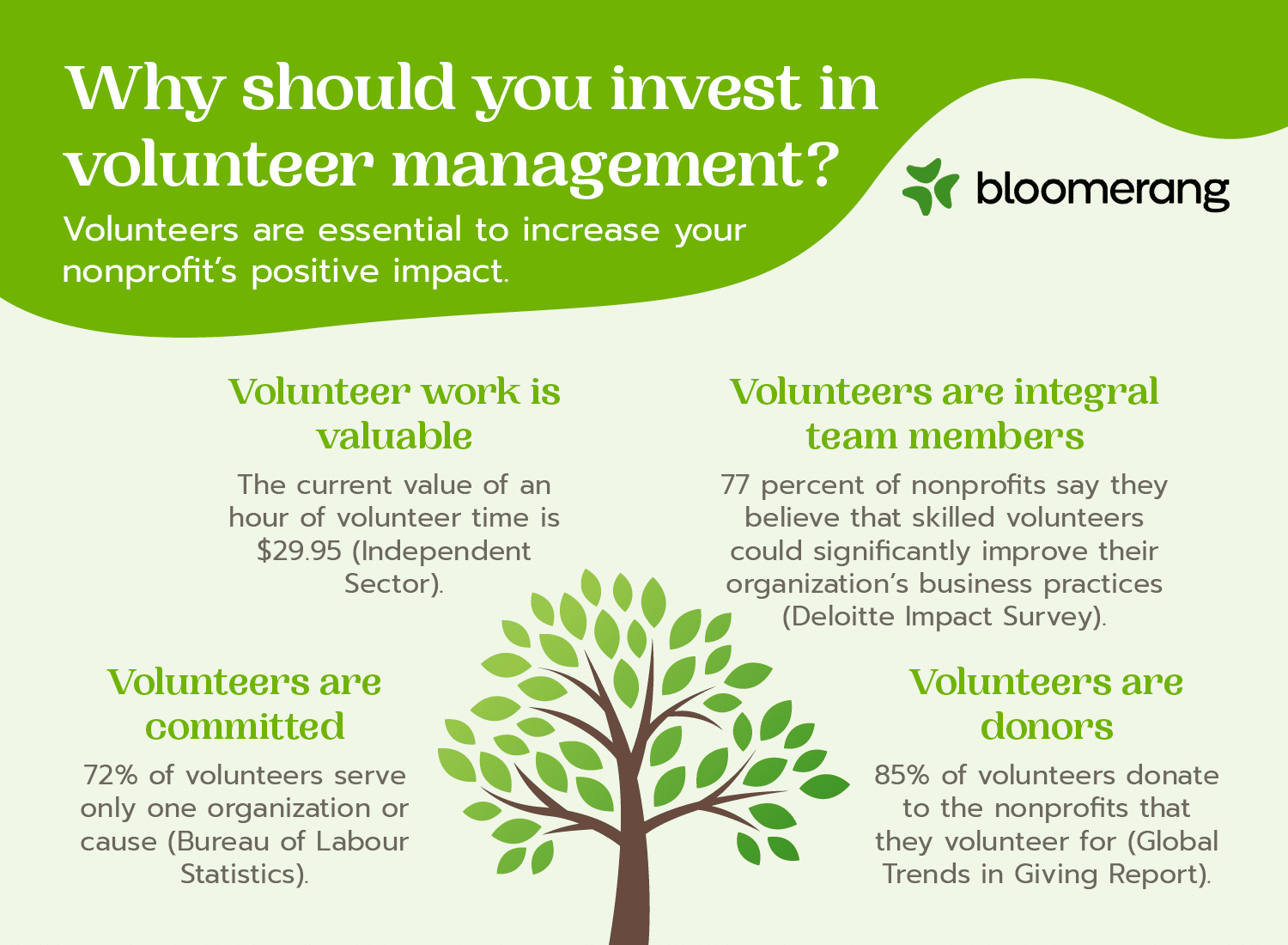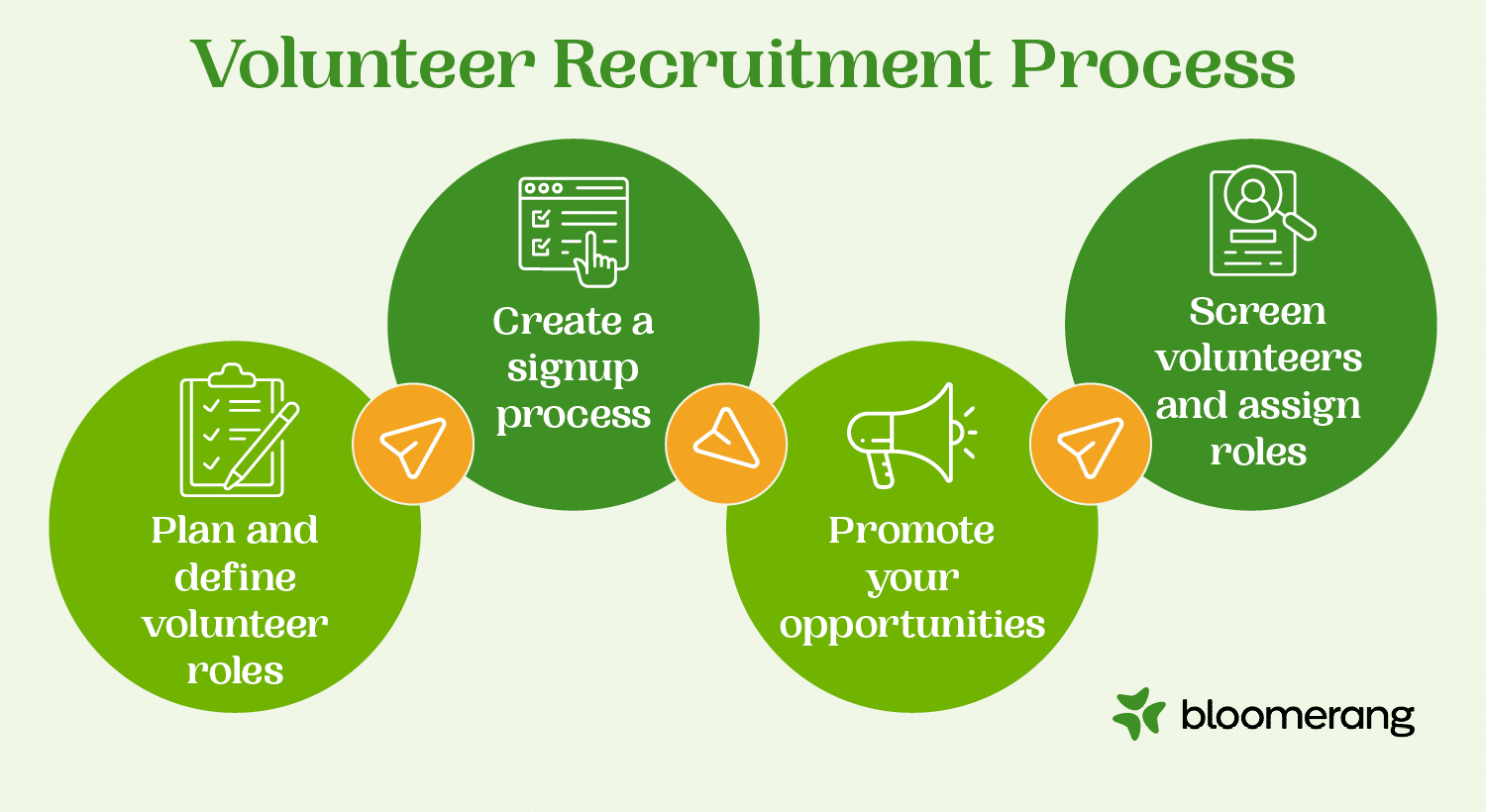The Smart Nonprofit’s Guide to Volunteer Management



Volunteers make up an essential part of a nonprofit’s workforce. In fact, about a third of Americans volunteer each year. Effective volunteer management vital to an organization’s day-to-day operations, meaning nonprofits need to invest in smart volunteer management practices to reduce administrative overhead and increase volunteer retention.
This article will ensure your organization is equipped with up-to-date information, best practices, and guidelines for managing your volunteer workforce successfully. Here’s what to expect:
Your volunteer management strategy shouldn’t be a secondary consideration. Instead, it’s the foundation of your volunteer program and a top priority for your nonprofit. Strong management practices mean that you’ll be able to recruit the right volunteers and retain them for the long term.
Volunteer management is the process that a nonprofit organization uses to recruit, track, engage, and retain volunteers. By developing a strong volunteer management strategy, a nonprofit’s team can build a positive and immersive volunteer experience that will help cultivate lasting, mutually-beneficial supporter relationships.
Volunteers are the unsung heroes of most nonprofits’ ongoing programming efforts and fundraising events. They’re your organization’s brand and mission ambassadors in the community and directly impact your organization’s success. Volunteers offer a tremendous amount of value and can thrive when given the right tools and resources.
This infographic outlines the value of volunteers:

Your volunteer management strategy will be unique to your organization. However, the basic steps of the volunteer management process will look similar across all nonprofits.
The volunteer management process will always involve the following four stages: recruitment, training, and stewardship/retention. Let’s take a closer look at how you can optimize each stage for more successful volunteer management.
Recruiting volunteers has never been easier—there is no need to rely on a sign-up sheet on a bulletin board anymore. Digital channels offer a convenient way to find new volunteers and provide them with a simple sign-up process.
Here are the steps of the volunteer recruitment process:

The goal of any successful volunteer recruitment plan should be to collect all the information required to place volunteers in roles where they will thrive. The simpler the sign-up process, the better. Ensure you are only collecting the relevant information you need to assess each application accurately.
Look for a volunteer management solution that allows you to ask logic-based questions during the sign-up process, reducing the number of fields a volunteer needs to answer. For example, if you need to know if someone is first-aid certified, your form could have a yes or no response, and then if a volunteer responds yes, the form could prompt them to provide a certificate.
The better the volunteer placement, the better the outcome for your organization and your volunteers. A satisfied volunteer shows up on time and comes back to volunteer more, helping you retain more volunteers in the long run.
The goal of your volunteer training and orientation should be to set your volunteers up for success by equipping them with the information and tools they need to thrive in their roles.
Send new volunteers a link to sign up for a training session as soon as you process their registration information. This helps maintain momentum and get volunteers involved as soon as possible.
Keep these volunteer training best practices in mind:
You never want to overwhelm your volunteers by making them jump through too many hoops. Keep things as straightforward forward as possible and ensure you only require training that is specific to the role or task a volunteer is responsible for.
From recruitment to training, your organization has invested a lot of effort into every volunteer, and they have invested in your organization’s success through their time and hard work. That’s why it is so important to continue to build relationships with volunteers through stewardship and recognition efforts.
Your volunteer recognition efforts don’t have to be complicated. Simple messages of appreciation or certificates of recognition can go a long way in making volunteers feel appreciated and helping retain them in the long run. You can also publicly recognize volunteers by sharing photos of them hard at work on your social media pages or website.
When volunteers feel appreciated for their efforts, they’ll be much more likely to stay involved with your organization.
Keeping volunteer information organized throughout every step of the management process is no simple task. Software solutions can simplify the process, giving you access to all the tools you need to manage volunteers in one convenient place. Let’s explore the ins and outs of volunteer management software and what it can do for your nonprofit.
Volunteer management software offers tools and features specifically designed to help increase the administrative efficiency of managing volunteer programs and events. A comprehensive volunteer management system should provide volunteer coordinators and managers with tools to recruit, screen, schedule, manage, and communicate with volunteer workforces through a single system.
Volunteer management software should also provide volunteers with a smooth user experience during the sign-up and scheduling process, as well as communication tools that allow them to contact their volunteer manager. A volunteer management system’s role is to eliminate any miscommunication and no-shows, reduce administrative time, and increase volunteer retention.
If your nonprofit needs a new volunteer management system, look for one that offers the following features:
Along with these features, some volunteer management platforms allow you to track both volunteers and donors in one system, giving you a holistic view of all supporters. Organizations interested in tracking all of their supporter information in one place may benefit from investing in a comprehensive solution.
An integrated volunteer and donor management platform offers the following benefits:
Learn more about the benefits of integrated donor management and volunteer management software with our recent blog post.
Here are a few final tips to ensure that your volunteer management strategy is robust and sustainable:
Recruiting new volunteers to your organization requires a multi-channel marketing approach, which leverages all of your existing online channels and partnerships with other organizations to spread the word. To help you implement effective communication practices, let’s walk through four primary channels that will enhance your volunteer recruitment process.
If you already have a list of volunteers who have worked at previous events you’ve organized, make them feel appreciated by giving them exclusive access to available positions. Encourage your email recipients to share volunteer opportunities with their friends and family. Consider offering a referral thank you gift as an incentive.
Keep your volunteer opportunities page up to date, providing potential volunteers with an easier way to sign up for any opportunities that interest them. Ensure your volunteer web page is optimized for mobile use to give mobile visitors a streamlined, convenient experience.
Use social media platforms like Facebook, Instagram, and Twitter to promote your volunteer opportunities and share information about the purpose and success of the program. Share videos and photos from past volunteer opportunities to thank volunteers for their involvement and show potential volunteers how much fun they can have by getting involved.
Consider partnering with other local nonprofit organizations to help spread the word to a broader audience. The partnership should be a mutually beneficial one where you both support each other’s recruitment efforts through social media posts or email messages.
Keeping track of your volunteers’ interests, goals, and skills ensures they have a fulfilling experience with your organization and guarantees that your nonprofit makes the most of what they have to offer.
When volunteers register for the first time, ask a few questions about what skills they have to offer that are relevant to your nonprofit’s needs, such as graphic design or social media marketing experience. Note these skills in your volunteer database and use your communications to highlight opportunities that appeal to volunteers.
Volunteers will find greater long-term fulfillment from working with your organization if they have the opportunity to use their unique talents to make a difference.
Volunteer feedback is valuable to help improve everything from operational planning to organizational culture. Receiving insight from your volunteers can help you understand their needs and wants, which ultimately helps retention.
Consider sending a simple survey to volunteers after they complete a shift or take the time to grab a coffee with a small volunteer group once a month and discuss how you could improve their experience. Document the feedback you receive in your volunteer management software, and put the insights into action as you plan your next program or initiative.
A lot goes into successfully managing volunteers, but the rewards are well worth the work. Effective volunteer management leads to better volunteer retention, keeping your volunteer program strong and stable for years to come.
Comments